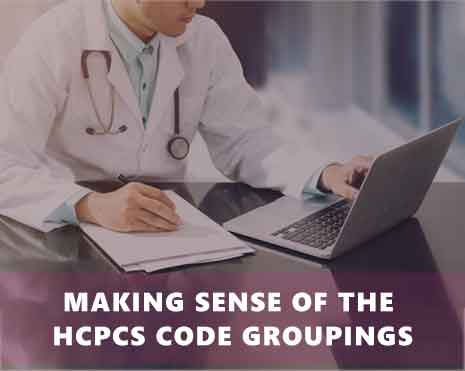In last week’s post, we provided an overview of the Healthcare Common Procedure Coding System (HCPCS) code. This code set is administered by the Centers for Medicare and Medicaid Services (CMS), and is it used primarily to bill government payers (although some private payers also utilize the HCPCS code set). HCPCS Level I is identical to the CPT code set, but Level II is used to identify a wide range of products and services that are not included in CPT-4.
Each of the HCPCS Level II codes is five characters long and begins with a capital letter. This letter denotes the grouping under which the code falls. Thus, you can identify the type of product or service that is being provided based on the first letter. The following groups are included in HCPCS Level II:
1. A-Codes cover ambulatory services, including transportation and medical and surgical supplies. This grouping also covers miscellaneous and experimental ambulatory services.
2. B-Codes include enteral and parenteral therapy, which typically refers to the provision of nutrients in order to restore a patient to a healthy nutritional status.
3. C-Codes are used to bill Medicare for outpatient hospital services under its Prospective Payment System.
4. D-Codes are used to bill for dental services.
5. E-Codes cover all durable medical equipment.
6. G-Codes are assigned for temporary procedures and professional services.
7. H-Codes cover rehabilitation services.
8. J-Codes cover chemotherapy drugs and all other prescription pharmaceuticals that are administered in any manner other than the oral method.
9. K-Codes are temporary codes that cover durable medical equipment offered only by regional carriers.
10. L-Codes cover all services related to orthotics and prosthetics.
11. M-Codes cover general medical services that do not fit into any of the other groupings.
12. P-Codes are used to bill for pathology and laboratory services.
13. Q-Codes are used as temporary placeholders in cases where a permanent code cannot yet be assigned. When a permanent code is assigned, the Q code is deleted and replaced.
14. R-Codes cover diagnostic radiology services.
15. S-Codes are codes that are used by private payers that utilize the HCPCS code set. These codes are not used on claims submitted to Medicare or Medicaid.
16. T-Codes are specific to state Medicaid agencies.
17. V-Codes cover all vision and hearing services.
It can be hard to keep track of all the codes that fall within these groupings. To help your medical billing team avoid making mistakes when billing government payers or private payers that utilize the HCPCS code set, you may want to consider outsourcing to the medical coding and billing experts at AnnexMed. With our expertise, we can ensure that the complexities of the HCPCS code set won’t interfere with your revenue cycle. Contact us today to learn more about our services!


